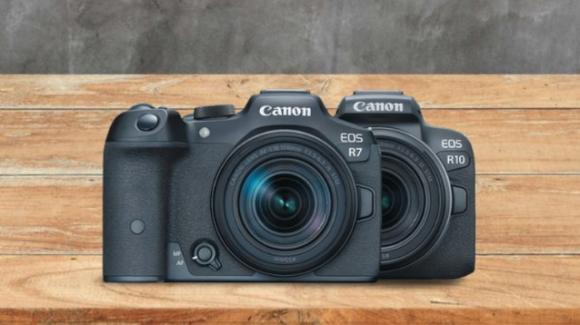Expected for a few weeks by the trade press, and by fans of the mirrorless genre, the new Canon EOS R7 and R10 cameras, with APS-C format and accompanying lenses, have recently been presented.
Listen to this article
During a press event that also unveiled the new accompanying lenses, the Japanese brand Canon, now completed the M series with the EOS M50 II model, switched to the new series of mirrorless R, with APS-C format which, substantially in the Canon EOS R7 and Canon EOS R10 cameras, they constitute a decisive challenge to the similar solutions proposed in the lists of rivals Fujifilm and Sony.
United by different specifications, in addition to the aforementioned APS-C format, both cameras are moved by the Digic X image processor: the mechanical shutter allows bursts of 15 shots per second against the guaranteed 23/30 of the electronic one. The video recordings, in both models, arrive at 4K at 60p, or at 4K a30p in oversampled, and there is no shortage of functions for live streaming on YouTube.
As already seen on the Canon EOS R5, EOS R6 and EOS-1D X Mark III models, the “Dual Pixel CMOS AF” focusing, in tandem with deep learning, makes it practically impossible to miss the right moment, maximizing your percentage. successful in catching it, even in very chaotic events such as an award ceremony or a wedding. Still among the lowest common denominators, the Canon EOS R7 and Canon EOS R10 include the microUSB Type-C for powering and charging.
Heir to the EOS M6 II, in the Canon EOS R7 (July, 1569.99 euros for the body only, rising to 1979.99 with the RF-S 18-150mm f / 3.5-6.3 IS STM lens) there’s more, in addition to the renewed 32.5 megapixel sensor, capable of recording in 4K at 60p without crop, also taking into account the proprietary Cinema Gamut and Log 3 profiles: accompanied by a 5-axis IBIS stabilization up to 8 stops, an autofocus with tracking, and from leveling the horizon (via Auto-level), the new and massive 612 grams with battery) premium mirrorless features a 2.36 million dot electronic viewfinder for 120 fps and an adjustable 7.5 cm display. To the general picture of the model contribute to the Wi-Fi connectivity, Bluetooth, the double slot for UHS-II SD card, the combo jack for microphone / headphones, and the ability to shoot those vertical videos that are so fashionable today.
The EOS R10 (426 grams, 429 with battery, 122.5 × 87.8 × 83.4mm) is destined (July, for 1,029 euros rising to 1149 with the RF-S 18-45mm f / 4.5 lens -6.3 IS STM) to a younger audience, but not for this reason it is less performing, strong also of the autofocus capable of tracking various subjects, being able to challenge the rival A6600 by beating it for the ability to push (as an alternative to those in 4K at 30p derived from 6K oversampling and those in timelapse 4K) the recordings up to 4K @ 60p via crop, and for the rapidity of the bursts that here reach 23 fps with the electronic shutter or 15 with the mechanical shutter (vs 8 fps with the shutter in silent mode of the fearsome Sony alternative). The touchscreen (from 2.95 ″ to 1.04 million points) here too can be oriented and there is no shortage of the electronic viewfinder (from 2.36M dot OLED to 60 / 120fps) or the slot for the UHS-II SD but, in terms of jack, the same only supports the external microphone and not the headphones as well.

